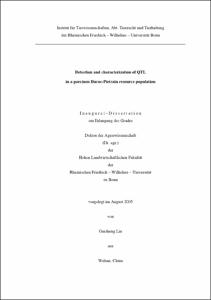Liu, Guisheng: Detection and characterization of QTL in a porcinen Duroc-Pietrain resource population. - Bonn, 2005. - Dissertation, Rheinische Friedrich-Wilhelms-Universität Bonn.
Online-Ausgabe in bonndoc: https://nbn-resolving.org/urn:nbn:de:hbz:5N-06470
Online-Ausgabe in bonndoc: https://nbn-resolving.org/urn:nbn:de:hbz:5N-06470
@phdthesis{handle:20.500.11811/2205,
urn: https://nbn-resolving.org/urn:nbn:de:hbz:5N-06470,
author = {{Guisheng Liu}},
title = {Detection and characterization of QTL in a porcinen Duroc-Pietrain resource population},
school = {Rheinische Friedrich-Wilhelms-Universität Bonn},
year = 2005,
volume = 131,
note = {In the present thesis, genome scans were performed for QTL detection in a F2 resource population which was reciprocally crossed between Duroc and Pietrain. 1085 F2 progeny within 38 full-sib families were produced from these three generations of commercial pigs. These animals were characterized for 73 informative microsatellites that covered 79.5 % of 18 sus scrofa autosomes according to USDA/MARC.2 map. Genetic maps were constructed by Crimap software. Female maps, male maps and sex average maps were 2142.8 cM, 1660 cM and 1821.6 cM Kosambi, respectively. Least square regression interval mapping was conducted for QTL detection between these molecular markers and 32 phenotypic traits. These traits included body weight, growth traits, body composition and meat quality. Significant thresholds were determined by permutation test. In total, seventy-one QTL were identified on almost all autosomes except SSC10 by the one-QTL model. Among those QTL, fifty-two QTL were detected at the 5 % chromosome-wide significant level, ten QTL on SSC1, SSC2, SSC6, SSC8, SSC16 and SSC17 were significant at the 5 % genome-wide level, nine QTL on SSC1 and SSC7 were significant at the 1 % genome-wide level. For meat pH value which was measured post-mortem in m. long. dorsi and in m. semimembranosus, respectively, two QTL were exceeding the 1 % genome-wide threshold in the same region on SSC1, confidence interval was 20 ~ 42 cM. Our results are valuable and interesting for further work such as fine mapping in this region, then identification of positional candidate gene, in order to improve the meat quality. Furthermore, our findings demonstrated that the statistical power of QTL mapping could be increased considerably by multiple QTL analyses. Identical results were obtained by cofactor analyses and by the two-QTL model analyses. Thirteen suggestive imprinted QTL for fat traits and leanness traits were obtained on SSC2, SSC5, SSC6 and SSC11. By using two-QTL model with imprinting, also by using cofactor analyses, two QTL were found simultaneously segregation on SSC2: one indicated imprinting expression, mainly paternal expression in the proximal region; another indicated Mendelian expression in the distal region.},
url = {https://hdl.handle.net/20.500.11811/2205}
}
urn: https://nbn-resolving.org/urn:nbn:de:hbz:5N-06470,
author = {{Guisheng Liu}},
title = {Detection and characterization of QTL in a porcinen Duroc-Pietrain resource population},
school = {Rheinische Friedrich-Wilhelms-Universität Bonn},
year = 2005,
volume = 131,
note = {In the present thesis, genome scans were performed for QTL detection in a F2 resource population which was reciprocally crossed between Duroc and Pietrain. 1085 F2 progeny within 38 full-sib families were produced from these three generations of commercial pigs. These animals were characterized for 73 informative microsatellites that covered 79.5 % of 18 sus scrofa autosomes according to USDA/MARC.2 map. Genetic maps were constructed by Crimap software. Female maps, male maps and sex average maps were 2142.8 cM, 1660 cM and 1821.6 cM Kosambi, respectively. Least square regression interval mapping was conducted for QTL detection between these molecular markers and 32 phenotypic traits. These traits included body weight, growth traits, body composition and meat quality. Significant thresholds were determined by permutation test. In total, seventy-one QTL were identified on almost all autosomes except SSC10 by the one-QTL model. Among those QTL, fifty-two QTL were detected at the 5 % chromosome-wide significant level, ten QTL on SSC1, SSC2, SSC6, SSC8, SSC16 and SSC17 were significant at the 5 % genome-wide level, nine QTL on SSC1 and SSC7 were significant at the 1 % genome-wide level. For meat pH value which was measured post-mortem in m. long. dorsi and in m. semimembranosus, respectively, two QTL were exceeding the 1 % genome-wide threshold in the same region on SSC1, confidence interval was 20 ~ 42 cM. Our results are valuable and interesting for further work such as fine mapping in this region, then identification of positional candidate gene, in order to improve the meat quality. Furthermore, our findings demonstrated that the statistical power of QTL mapping could be increased considerably by multiple QTL analyses. Identical results were obtained by cofactor analyses and by the two-QTL model analyses. Thirteen suggestive imprinted QTL for fat traits and leanness traits were obtained on SSC2, SSC5, SSC6 and SSC11. By using two-QTL model with imprinting, also by using cofactor analyses, two QTL were found simultaneously segregation on SSC2: one indicated imprinting expression, mainly paternal expression in the proximal region; another indicated Mendelian expression in the distal region.},
url = {https://hdl.handle.net/20.500.11811/2205}
}






